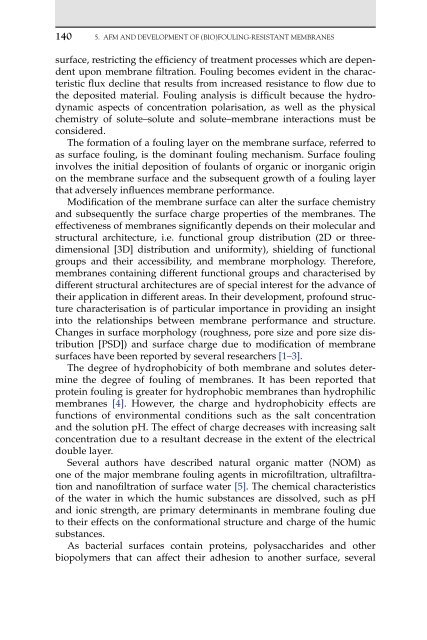W. Richard Bowen and Nidal Hilal 4
W. Richard Bowen and Nidal Hilal 4
W. Richard Bowen and Nidal Hilal 4
- No tags were found...
You also want an ePaper? Increase the reach of your titles
YUMPU automatically turns print PDFs into web optimized ePapers that Google loves.
140 5. AFM AND DEvELOPMENT OF (BIO)FOULINg-REsIsTANT MEMBRANEs<br />
surface, restricting the efficiency of treatment processes which are dependent<br />
upon membrane filtration. Fouling becomes evident in the characteristic<br />
flux decline that results from increased resistance to flow due to<br />
the deposited material. Fouling analysis is difficult because the hydrodynamic<br />
aspects of concentration polarisation, as well as the physical<br />
chemistry of solute–solute <strong>and</strong> solute–membrane interactions must be<br />
considered.<br />
The formation of a fouling layer on the membrane surface, referred to<br />
as surface fouling, is the dominant fouling mechanism. Surface fouling<br />
involves the initial deposition of foulants of organic or inorganic origin<br />
on the membrane surface <strong>and</strong> the subsequent growth of a fouling layer<br />
that adversely influences membrane performance.<br />
Modification of the membrane surface can alter the surface chemistry<br />
<strong>and</strong> subsequently the surface charge properties of the membranes. The<br />
effectiveness of membranes significantly depends on their molecular <strong>and</strong><br />
structural architecture, i.e. functional group distribution (2D or threedimensional<br />
[3D] distribution <strong>and</strong> uniformity), shielding of functional<br />
groups <strong>and</strong> their accessibility, <strong>and</strong> membrane morphology. Therefore,<br />
membranes containing different functional groups <strong>and</strong> characterised by<br />
different structural architectures are of special interest for the advance of<br />
their application in different areas. In their development, profound structure<br />
characterisation is of particular importance in providing an insight<br />
into the relationships between membrane performance <strong>and</strong> structure.<br />
Changes in surface morphology (roughness, pore size <strong>and</strong> pore size distribution<br />
[PSD]) <strong>and</strong> surface charge due to modification of membrane<br />
surfaces have been reported by several researchers [1–3].<br />
The degree of hydrophobicity of both membrane <strong>and</strong> solutes determine<br />
the degree of fouling of membranes. It has been reported that<br />
protein fouling is greater for hydrophobic membranes than hydrophilic<br />
membranes [4]. However, the charge <strong>and</strong> hydrophobicity effects are<br />
functions of environmental conditions such as the salt concentration<br />
<strong>and</strong> the solution pH. The effect of charge decreases with increasing salt<br />
concentration due to a resultant decrease in the extent of the electrical<br />
double layer.<br />
Several authors have described natural organic matter (NOM) as<br />
one of the major membrane fouling agents in microfiltration, ultrafiltration<br />
<strong>and</strong> nanofiltration of surface water [5]. The chemical characteristics<br />
of the water in which the humic substances are dissolved, such as pH<br />
<strong>and</strong> ionic strength, are primary determinants in membrane fouling due<br />
to their effects on the conformational structure <strong>and</strong> charge of the humic<br />
substances.<br />
As bacterial surfaces contain proteins, polysaccharides <strong>and</strong> other<br />
biopolymers that can affect their adhesion to another surface, several
















